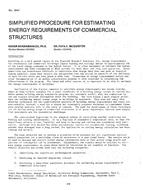Description
According to a well quoted report of the Stanford Research Institute, energy requirements for residential and commercial buildings (space heating and cooling) amount to approximately 20% of the total energy consumed in the United States. It is often necessary to estimate the energy requirements and fuel consumption of HVAC systems for both short and long term operation. These quantities can be much more difficult to caluculate than design heat loss and gain or required system capacity, since they involve the integration over the period in question of the influence of many factors which may vary greatly with time. Conparison of energy requirements before and after implementation of an energy conservation program is also essential in determining the effectiveness of the program. For these and other reasons it is important to be able to estimate the energy requirements of buildings.
Application of the digital computer to calculate energy requirements has become routine, where an hour-by-hour (usually for a year) simulation of a building energy system is carried out. While modern building energy simulation programs are extremely useful, they are cumbersome to use and require detailed information about the building. For this reason a much simpler procedure for estimating annual energy usage in buildings is desirable. This does not imply that existing techniques for the comprehensive analysis of building energy requirements and costs are unacceptable; instead, a need for a simple but reasonably accurate technique to complement these more complex analytic aids is the basis of concern. The need for development of these techniques for estimating energy usage of commercial structures is of great importance, because most simplified procedures are for residential dwellings.
The conventional degree-day is the simplest method of correlating weather conditions and heating and cooling requirements. It is a function of atmospheric temperature only, so that the significant effects of sun, humidity, and wind on heating and cooling are considered only indirectly . Although this method has shown satisfactory results for residential heating, utilizing weather data averaged over a long period, its application to cooling energy calculation has been limited and erratic.
The main objective of this paper was to develop a procedure which accounts for all significant environmental parameters for a particular class of structures on a year-round basis. The results would be used to process and analyze actual energy consumption data so that actual usage trends and patterns of consumption can be determined. Furthermore, the results would be utilized to estimate energy requirements in cases where detailed simulation is not possible or feasible. The overall objective was broken down into the following categories:
l. Identifying the significant environmental parameters.
2. Developing an improved degree-day concept.
3. Developing a simplified analytical procedure for estimating energy requirements of commercial structures
Product Details
- Published:
- 1981
- Number of Pages:
- 20
- File Size:
- 1 file , 1.7 MB
- Product Code(s):
- D-CI-2647
- Note:
- This product is unavailable in Russia, Belarus




